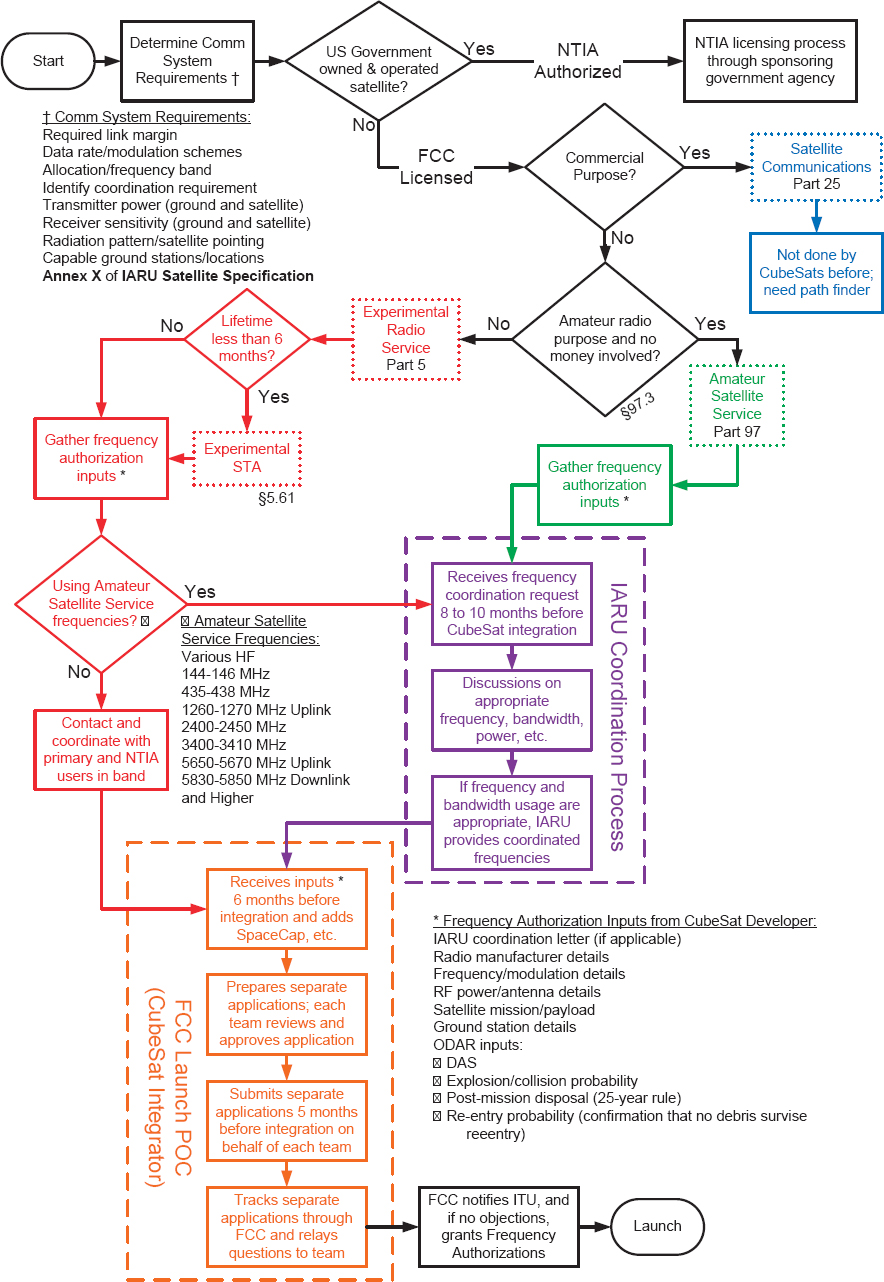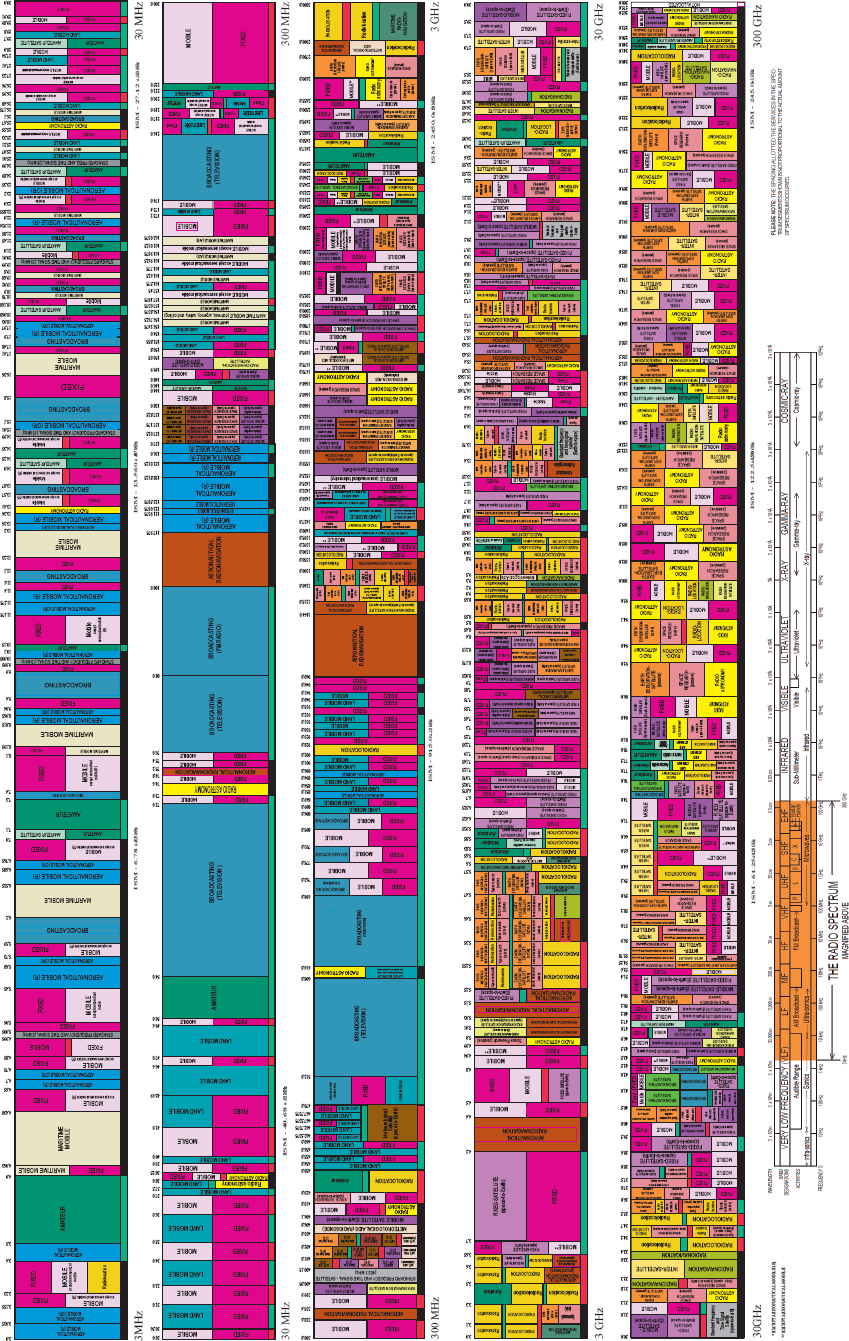C
Additional Technology and Policy Details
This appendix is written in support of the technology chapter (Chapter 5) and the chapter focused on policy-related issues (Chapter 6) to provide enhanced technical depth for the interested reader.
TRACKING TECHNOLOGY OPTIONS
Operationally, a space surveillance system perceives objects whose isotropic UHF radar cross sections are 10 cm diameter in low orbit. Tracking of CubeSats in this way can be active and cooperative (e.g., the owner/operator participates in tracking by emitting signals via a transponder, or sharing telemetry with JSpOC or other entities responsible for tracking spacecraft). Among active technology, there is development effort under way at the Air Force Research Laboratory and National Laboratories. Los Alamos National Laboratory, for example, is developing an optical beacon called ELROI (Extremely Low Resource Optical Identifier) to attach to everything that goes into space and broadcasts satellite identity at all times.
Tracking can also be passive and uncooperative (e.g., ground-based radar that radiates energy pulses that reflect off of the object back to a receiver without the object’s participation). Passive technology benefits from anything that increases the radar cross section (e.g., by the deployment of dipole structures) or increases the optical visibility (e.g., by the use of highly reflective surface materials). Corner cube retro-reflectors as a passive device are currently under development.
Tracking of deep space CubeSats for navigation is similar in nature to the tracking of large missions. It involves communication with the Deep Space Network (DSN), but in the case of the lunar CubeSats, tracking and commanding may be achieved via antennae outside the DSN. Deep space tracking and navigation are planned for demonstration with the INSPIRE and MarCO missions.
DEORBIT CONTROL AND SPACE DEBRIS MITIGATION
The control of orbital debris involves both regulatory and technological issues. Most technologies that mitigate the negative effects of CubeSats’ contribution to space debris are focused on their removal from orbit and subsequent disintegration when reentering the Earth’s atmosphere. As such, these technologies are directly linked to the ability of CubeSats to modify their orbits, passively or actively. These have been discussed already in the
subsection “Mobility and Propulsion” of this report. However, in a more general sense, the problem of debris control includes situations when nonresponsive spacecraft need to be actively tracked down and deorbited.
Currently, there is no deorbiting system that could remove space debris from orbit. Nevertheless, there is a large amount of work under way related to this effect, primarily dedicated to spacecraft larger than CubeSats. In particular, there is interest in the removal of space debris from geostationary orbits (no deorbit in this case) and large rocket stages and components. The largest threat to operational satellites comes from smaller debris in low Earth orbit (LEO), objects with dimensions of 10 cm or smaller, which can include inactive CubeSats. In most cases, a spacecraft is used to rendezvous and force the debris into an orbit that facilitates deorbit. Relevant technologies include those for identifying target properties, performing flight formation with non-cooperative targets, and docking and propulsive tugging. Switzerland’s CleanSpace One is an example using a 3U CubeSat to demonstrate this capability by deorbiting a 1U CubeSat by 2017.
Other approaches, known as “sweepers,” would capture small objects onto a large but light aerogel-based structure and then reenter Earth’s atmosphere using onboard propulsion. Other approaches include the use of ground- and space-based lasers that would target debris and ablate a fraction of their surfaces, thus imparting momentum to decrease their orbital energies.
Table C.1 shows the mission capabilities for some of these micro-propulsion options for CubeSats together with their quoted technology readiness level (TRL), a scale from 1-9 to define the development state, with 1 being pure conceptual and 9 reserved for mission-proven, readily available, and reliable technologies.
RADIO SPECTRUM BACKGROUND
The radio spectrum is exceedingly valuable. Auctions of radio spectrum for various uses such as cellular phones, paging, and broadcast have raised well over $50 billion in the United States since auctions were first used as a licensing tool in 1994. But the value of the radio spectrum as an economic driver is estimated to be much larger still, with a tremendous variety of commerce enabled or assisted by wireless services. The direct value of spectrum is driven by demand for wireless services and broadband access, while its indirect value is related to its use for the public good, such as air traffic control, public safety, national defense, weather monitoring and prediction, and science.
In the United States, spectrum is regulated by two separate agencies. Federal government users of the radio spectrum (NASA, the National Oceanic and Atmospheric Administration, the Department of Defense, the Federal Aviation Administration, and others,) are regulated by the National Telecommunications and Information Administration (NTIA), a component of the Department of Commerce. All other users of the spectrum (private citizens, state and local governments, and businesses, etc.) are regulated by the Federal Communications Commission (FCC), an independent agency. Whether a CubeSat is considered a federal government satellite or not may sometimes not be entirely clear, as discussed below, but the developer must determine this before embarking upon the licensing process. The FCC and the NTIA have entirely different processes for obtaining spectrum authorizations. The complexity of the licensing process is shown in Figure C.1.
The United States is also a signatory to the Radio Regulations1 issued by the International Telecommunication Union (ITU), a specialized agency of the United Nations. Particularly with regard to satellite use, the United States has agreed to abide by the Radio Regulations to the extent required to avoid interference to radio services of other nations. The practical impact to CubeSat developers is that a filing to the ITU will typically be required, in addition to the domestic regulatory filings.
The radio spectrum (which is defined as all frequencies below 3 THz) is divided into roughly 600 different bands. Each band is allocated to one or more services, such as mobile, broadcast, and Earth exploration satellite, to name a few of the ~30 different services. While some bands are reserved for federal government (NTIA) use only, and other bands are held for nongovernment (FCC) use only, most of the spectrum is shared between federal government and nongovernment users. Figure C.2 is a graphical representation of how the radio spectrum is allocated across bands and services.
___________________
1 International Telecommunication Union, edition of 2012,”Radio Regulations,” https://www.itu.int/pub/R-REG-RR.
TABLE C.1 Propulsion Technologies for CubeSats
| Thruster | Propellant | Pressurization | Isp (s) | Size (U) | Power Efficiency | Thrust (mN) | TRL |
|---|---|---|---|---|---|---|---|
| Hydrosa | Water | No | 60 (cold gas)-300 | 1 | N/A | <800 | 4 |
| Hydrazine Aerojet MPS-120b | Hydrazine | Yes | 220 (est) | >1 | N/A | 260-2800 | 6 |
| Electrospray Busek, MITc | Ionic Liquid | No | 1100-2300 | 0.2-1 | 30-70% | 0.1-1 | 5 |
| Vacuum arc uCAT (GWU), VAT (Alameda)d | Metal | No | 1500-3000 | 0.2 | 9-15% | 0.001-0.050 | 4 |
| Pulsed Plasma Thrusters Busek BmP-220e | Teflon | No | 536 | 0.7 | <10% | <0.1 per pulse | 5-7 |
| Ion Thrusters MiXI JPLf Busek BIT-1,3 | Xenon, Iodine | Yes (Xenon), No (Iodine) | 2000-3200 | 1-2 | 20% | 0.5-3 | 3 |
| CAT | Xenon | Yes | 400-800 | 2 | <40% | 0.5-4 | 3 |
| Monoprop greeng Busek GMT | AF-M315E | Yes | 220 | >1 | N/A | 500 | 5 |
| Solar Sail | Sun | No | N/A | >2 | N/A | 1 for 8002 m2 at 1 AU | 5 |
| Cold gas VACCO/CU Aerospaceh | Sulfur dioxide | Yes | 70 | 1 | N/A | 450 | 6 |
| Solidi DSSP | HIPEP-501A | No | 900 | 0.5 | N/A | 300 (250 pulses, 2 ms each) | 9 |
a Tethers Unlimited, “HYDROS Thruster: Powerful ‘Green’ Propulsion for Small Satellites,” brochure, http://www.tethers.com/SpecSheets/Brochure_HYDROS.pdf.
b Aeroject Rocketdyne, “MPS-120™ CubeSat High-Impulse Adaptable Modular Propulsion System (CHAMPS),” http://www.rocket.com/CubeSat/mps-120, accessed April 8, 2016.
c Busek Space Propulsion and Systems, http://www.busek.com/, accessed April 8, 2016; D. Krejci, F. Mier-Hicks, C. Fucetola, A. Hsu-Schouten, F. Martel, and P. Lozano, 2015, “Design and Characterization of a Scalable ion Electrospray Propulsion System,” paper presented at Joint Conference of 30th International Symposium on Space Technology and Science, 34th International Electric Propulsion Conference and 6th Nano-satellite Symposium, Hyogo-Kobe, Japan, http://erps.spacegrant.org/uploads/images/2015Presentations/IEPC-2015-149_ISTS-2015-b-149.pdf.
d M. Keidar, S. Haque, T. Zhuang, A. Shashurin, D. Chiu, and G. Teel, 2013, “Micro-Cathode Arc Thruster for PhoneSat Propulsion,” Proceedings of the AIAA/USU Conference on Small Satellites, Technical Session VII: Propulsion, SSC13-VII-9, http://digitalcommons.usu.edu/cgi/viewcontent.cgi?article=2964&context=smallsat.
e Busek Space Propulsion and Systems, http://www.busek.com/, accessed April 8, 2016.
f R.W. Conversano and R.E. Wirz, 2013, Mission capability assessment of CubeSats using a miniature ion thruster, Journal of Spacecraft and Rockets 50(5):1035-1046.
g Busek Space Propulsion and Systems, http://www.busek.com/, accessed April 8, 2016.
h VACCO Industries, “MEPSI Micro Propulsion System,” http://www.vacco.com/images/uploads/pdfs/MicroPropulsionSystems_0714.pdf, accessed April 18, 2016.
i Digital Solid State Propulsion, “CAPS-3,” brochure, http://dsspropulsion.com/wp-content/uploads/2015/07/Brochure-Inlet-CAPS-3-Website.pdf.
INTEGRATION WITH LAUNCH VEHICLE
NASA’s Launch Services Program has awarded multiple Venture Class Launch Services contracts to support this emerging sector of the launch business, and it will support the agency’s CubeSat Launch Initiative. The three selected companies are Firefly Space Systems Inc. (400 kg into low Earth orbit for $8 million), funded at $5.5 million; Rocket Lab USA Inc. (up to 45 kg into low Earth orbit for $2.5 million), funded at $6.9 million; and Virgin Galactic LLC (200 kg into a Sun-synchronous orbit, and up to 400 kg into other low Earth orbits (LEOs), for less than $10 million), funded at $4.7 million.


Other examples include the recently canceled Defense Advanced Research Projects Agency (DARPA) Airborne Launch Assist Space Access (ALASA) program, which was at TRL5,2 targeting a payload of 45 kg into low Earth orbit for $1 million, with a lead time of 24 hours launching from an F-15E jet. CubeCab are developing another airborne system that will be launched from an F-104 jet; this is a CubeSat-specific system, however. With a TRL of 4, the projected launch costs are around $100,000/U, putting it on par with current commercial CubeSat launch costs. Another airborne system is the Bloostar launch vehicle, which uses a helium balloon to reach 20 km, after which a three-stage rocket system will insert up to 75 kg into a 600 km polar orbit for between €2 million and €4 million.
___________________
2 C. Frost, E. Agasid, D. Biggs, J. Conley, A. Dono Perez, N. Faber, A. Genova, A. Gonzales, A. Grasso, J. Harpur, S. Hu, et al., Mission Design Division, 2014, Small Spacecraft Technology: State of the Art, NASA Technical Report TP-2014-216648/REV1, NASA Ames Research Center, Moffett Field, California, http://cmapspublic3.ihmc.us/rid=1NG0S479X-29HLYMF-18L7/Small_Spacecraft_Technology_State_of_the_Art_2014.pdf.






